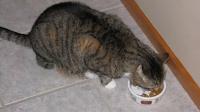Pet Health: Nutrition
For generations, dogs and cats ate leftovers from the family table in addition to whatever they could catch and eat outdoors. No one gave any thought to dog or cat nutrition, or providing them with the best pet foods. They seemed to do just fine.
After World War II, commercial pet food became more common. The economy had improved and people liked the convenience. Pet food companies had an inexpensive supply of ingredients from the “waste” not used for human food. The companies were not concerned about pet health, nutrtion was barely an afterthought.
Dog and Cat Diet
All dogs and cats need protein. Cats have a higher requirement for protein than dogs and they need to get taurine, an amino acid, in their diet.
Dry food alone is often not the best choice for a cat diet. They need more moisture in their food, especially if they have urinary tract problems.
Fat is also needed in a dog or cat diet. Specifically their diet needs the omega-6 fatty acid, linoleic acid, which is found in animal fat plus certain vegetable oils. Cats also need the fatty acid, arachidonic acid, from animal fat.
There is no specific dog or cat nutrition requirement regarding carbohydrates when considering pet feeding. However, carbs can provide energy and fiber can help intestinal function.
Puppies of large breeds can develop certain bone problems due to nutritional factors. To prevent problems it is important to control their weight to slow down their growth. These puppies need to stay on the lean side. Limiting protein makes no difference, but an excess of calcium can also cause problems.
AAFCO Dog and Cat Nutrition
The American Association of Feed Control Officials (AAFCO) is an organization that establishes pet health nutrition standards for pet foods. AAFCO does not regulate, test, approve, or certify pet foods. However, many states require manufacturers of pet feeding supplies to follow AAFCO standards.
As our pets live longer lives, their nutrition becomes more critical. We assume pet foods contain all the nutrients required by dogs and cats to live long, healthy lives. However, the AAFCO standards are based on the current knowledge of what nutrients are adequate for either growth or maintenance. The standards are not created based on what is needed to prevent disease or for longevity. The requirements ensure the pet will “survive”, not “thrive”.
An example of AAFCO limitations occurred with taurine in cats. Researchers in 1987 discovered cats had fatal heart problems because they were eating a commercial cat diet without enough taurine.
Complete and Balanced
For companies to say their food is “complete and balanced” for pet feeding, the company has to certify it in one of two ways. The first method is for the company to analyze the food. The food must have the proper amount of all recognized essential nutrients.
The second method, considered better, is a pet feeding trial. It involves feeding the dog or cat diet to pets for a certain time, 10 weeks for puppies and kittens and 26 weeks for adult pets, making sure they are healthy at the end of the trial. Neither method tells you the quality of the ingredients or how well your pet uses them.
Fiber
Fiber may be added to keep the stools firm yet moist so they move properly through the intestines. Some fibers are slightly digestible and others are not. Some improve the health of the intestines. Cellulose, beet pulp, oat fiber, and wheat bran are all fiber. Grains will provide fiber in the dog or cat diet as well.
A food that is high in fiber will not be very digestible since the fiber doesn’t digest down into nutrients your pet’s body can use. Your pet needs to eat more high fiber food in order to get enough nutrients and your pet will produce more stool. Fiber can help with Diarrhea in Pets, as well as Dog and Cat Constipation, and can even help Chubby Pets feel full while dieting!
Grain-Free Dog or Cat Diet
Grain-free diets aren’t necessarily the best pet foods for pet health & nutrition. These diets are not automatically low in carbohydrates because many have starches such as potatoes or tapioca in place of grains. They tend to be very digestible due to low fiber and they will help if your pet is allergic to grains.
Lamb and Rice
Some people have a misconception that these diets are better. Years back lamb and rice formulas were used to test pets for food allergies. The only reason those foods were used was because they were not typically used in a dog or cat diet at that time. In addition, most people could find lamb to feed their pets. When doing a food allergy trial you have to pick a protein and carbohydrate source that the pet hasn’t eaten before.
Somewhere along the way, a manufacturer decided that lamb and rice must be better since vets were recommending it and put it in their food. All that means is we can no longer use lamb and rice to check for food allergies! It has also made it more difficult for pet parents to find a meat if they want to test their pets for food allergies.
Lamb is actually a poor dog or cat diet choice for skin problems because all meats tend to generate heat in the body and lamb is the “hottest” of the meats. This adds to the inflammation that you see as red areas in the skin. Lamb and rice is acceptable for most pets, but don’t buy it thinking it’s better.
Summary
Despite the limitations, the current pet health nutrition standards are the ones used when a company makes a dog or cat diet. It is based on what they know about dog and cat nutrition today. To avoid possible deficiencies, some animal nutritionists advise switching among several foods with different ingredients every few months.
Recommendations for Best Pet Foods
“What should I feed my pet?” Veterinarians get very little training in nutrition, and there is too much conflicting information. It should be easy to pick a bag off the shelf that says complete and balanced and not worry about what’s in it.
Unfortunately, it’s not that simple. Learn how to read a pet food label and ingredient list. The packaging can be misleading. The label and ingredient list will help you understand what is in that bag or can of food you buy and give you some guidelines on how to judge the quality of the ingredients.
Will this bag of food help my pets have great health and a long life?
Some people don’t like all the unknowns of commercial pet foods. They decide to cook for their pets or feed a raw diet. These are reasonable options, but have their own set of problems.
Artificial preservatives and colors don’t belong in pet food. Your pets can’t see the colors and why use anything artificial if you don’t need to? It’s also best to avoid ingredients like animal by-product, corn, corn gluten meal, wheat and soy. The first 5 ingredients in the best pet foods should include a real meat protein, and healthy choices for carbs like rice or brown rice, potato or sweet potato, as well as healthy vegetables. Don't forget, canned food is best for cats.
Some commercial products are definitely better than others are. Take the time to read labels and check websites for information.
If you want to read more about pet health, nutrition, best pet foods and ingredients, check out Truth About Pet Food. Although the author has a bias against most commercial pet foods, there is good information on the site that will help you understand what’s happening in the pet food industry. The author reviews foods and includes her recommendations to consider.
All articles are reviewed and maintained by whiskerDocs team of veterinary experts.



